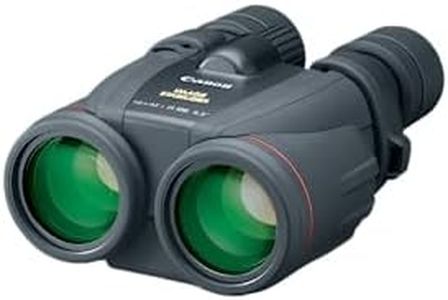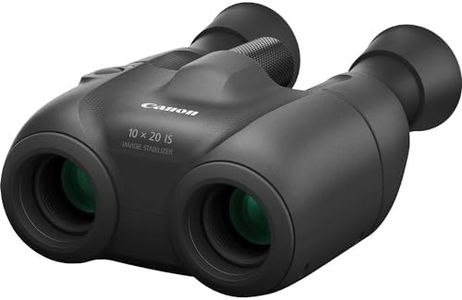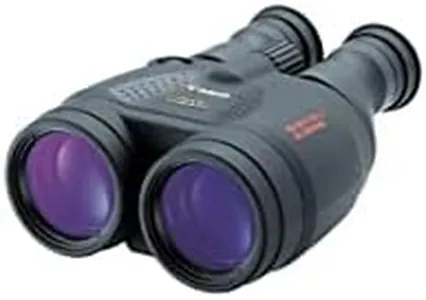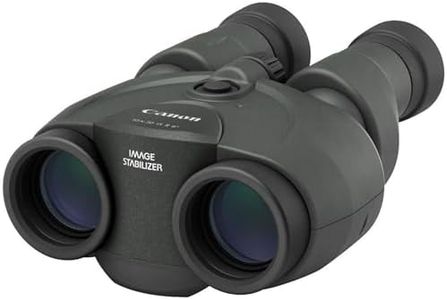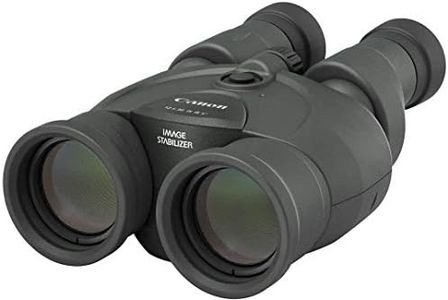We Use CookiesWe use cookies to enhance the security, performance,
functionality and for analytical and promotional activities. By continuing to browse this site you
are agreeing to our privacy policy
8 Best Canon Binoculars
From leading brands and best sellers available on the web.Buying Guide for the Best Canon Binoculars
Choosing the right binoculars can really improve your viewing experience, whether you're interested in bird watching, sporting events, stargazing, or traveling. The world of binoculars can seem overwhelming at first with all the numbers and features, but by understanding a few key specifications and matching them to how you intend to use your binoculars, you can make a choice that you'll be happy with for years.Magnification (e.g., 8x, 10x)Magnification tells you how many times closer an object will appear compared to seeing it with the naked eye. For example, '8x' means the image appears eight times larger. Lower magnification (like 8x) often provides a steadier image and a wider view, which is great for bird watching or following moving subjects. Higher magnification (like 10x or 12x) brings objects even closer but makes the image shakier if you're holding the binoculars by hand and limits your field of view. If you plan to use the binoculars for general use, wildlife, or sports, a moderate magnification (8x to 10x) is usually best. For stargazing or viewing objects at great distances, you might prefer higher magnifications, but these often work better with a tripod.
Objective Lens Diameter (measured in mm, e.g., 42mm)The size of the objective lenses (the big lenses at the end of the binoculars) determines how much light enters the binoculars. Larger lenses (like 42mm and above) gather more light and produce brighter images, especially in low-light situations like dawn, dusk, or stargazing. Smaller lenses (like 25mm or 32mm) make the binoculars more compact and lighter but might not perform as well in dim conditions. Choose larger lenses if you'll be using your binoculars in poor lighting or want the brightest possible image, but if portability and weight are more important (like for travel or day hikes), a smaller diameter works well.
Image StabilizationImage stabilization is a technology that helps reduce the shakiness caused by hand movements when holding binoculars. This feature is particularly important with higher magnification binoculars, where even the slightest shake is easily noticed. It's also helpful if you plan to use the binoculars for long periods, on boats, or for viewing distant objects. If you anticipate shaky hands, long viewing sessions, or want to use higher magnifications without a tripod, binoculars with built-in image stabilization can make a big difference to your experience.
Field of ViewField of view describes the width of the area you can see through the binoculars, typically measured in meters at 1,000 meters or in degrees. A wider field of view makes it easier to spot and follow moving subjects, like birds or athletes, and provides a more immersive experience. However, higher magnification usually means a narrower field of view. If you mostly want to observe fast-moving or widely spread-out subjects, prioritize a wider field of view. For viewing stationary or distant objects, a narrower field may be acceptable.
Weight and SizeThe size and weight of binoculars affect how comfortable they are to carry and use for extended periods. Bigger binoculars with large objective lenses and higher magnification usually weigh more and may require a tripod. Compact models are easier to carry for travel or day trips but might not offer the same bright, detailed image as larger ones. If you plan on carrying binoculars for long walks, travel, or adventure, choose a lightweight, compact model. If you'll mostly use them from a fixed location, you might prefer a larger model for the best viewing experience.
Eye ReliefEye relief is the distance you can hold the binoculars from your eyes while still seeing the full image. This is especially important if you wear glasses. Longer eye relief (usually specified as 15mm or more) makes binoculars more comfortable for glasses-wearers. If you wear glasses, look for binoculars with adjustable or long eye relief so you don’t miss any of the view. If you don’t wear glasses, eye relief is less critical, but good comfort is still important for long sessions.
Waterproof and Fogproof FeaturesBinoculars with waterproof and fogproof features are sealed to keep out moisture and dust, and sometimes filled with gases to prevent fogging. These features are important if you plan to use your binoculars in rain, near water, or in changing temperatures. For those who will be outdoors a lot, in all sorts of weather, or near water, choose binoculars with waterproofing and fog resistance; otherwise, standard models are usually fine for dry, mild conditions.

